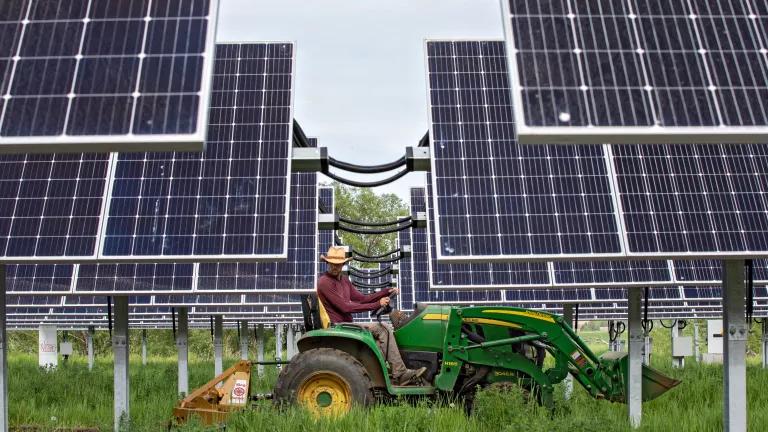China’s Top Industries Can Peak Collective Emissions in 2025
Joint research by NRDC and Chinese Academy of Environmental Planning (CAEP) finds that China’s top coal-consuming sectors—power, steel, cement, and coal-chemicals—can collectively peak both coal consumption and carbon dioxide emissions in 2025.

Written by: Jiayu Zhang and Hua Wen, NRDC China Program
Ahead of the COP 26 conference, China unveiled the first two policy documents of its “1+N climate policy framework”—which consists of a “1” document on guiding principles and an overarching “N” document on carbon peaking—providing a glimpse into China’s plans for fulfilling its climate commitments. While industry-specific targets are expected to be introduced in forthcoming sectoral action plans under the “N” series, joint research by the Natural Resources Defense Council (NRDC) and Chinese Academy of Environmental Planning (CAEP) finds that China’s top coal-consuming sectors—power, steel, cement, and coal-chemicals—can collectively peak both coal consumption and carbon dioxide emissions in 2025.
These four sectors contributed 72 percent of China’s carbon dioxide emissions and accounted for 86 percent of national coal consumption in 2019. Based on the new research of Coal Consumption Control Roadmap for Key Industrial Sectors under Dual Carbon Goals (executive summary in Chinese) by NRDC and CAEP, these four sectors together can peak their carbon dioxide emissions in 2025 at 8.01 billion tons, an increase of approximately 3 percent compared to 2019. The total coal consumption in the four sectors is also expected to peak in the same year at 2.49 billion tons coal equivalent (tce), with a 5-6 year-long plateau period into 2030 (see figure below).
Given differences in economic development, market demand, and technologies to shift away from coal in each sector, the report concludes that peak emissions in each sector would occur between 2020 and 2029.
The power sector will hit carbon peak around 2029
In addition to being China’s biggest coal user, the power sector is the nation’s single largest greenhouse gas emitter, contributing 42 percent of carbon dioxide emissions as of 2019. While the growing demand of electricity has slowed down compared to the early 2010s, especially in traditionally heavy industries, the electrification of industrial processes and the boom in data centers will continue to drive up emissions between 2021 and 2029—the year when the Chinese power sector could hit its carbon peak at 5 billion tons of carbon dioxide, representing an 8 percent increase from 2019. Coal consumption in the power sector, however, will peak one year earlier in 2028, at 1.63 billion tce. The delay in peaking carbon dioxide emissions is caused by continued growth in natural gas power generation.
Peaking emissions by 2029 will require at least a 7 percent cut in coal consumption in the power sector, compared with the business-as-usual scenario. Integrating more wind and solar power into the grid will play the largest part and help cut 60 percent of coal consumption needed to peak carbon emissions. Other important measures include improving energy efficiency in the existing coal fleet and adding biomass-based power plants and gas-based peaker plants into the system, according to the study.
Frontrunner companies in the power sector have targeted an early peak in emissions, including two of the “Big 5” state-owned power generation companies—State Power Investment Corporation (by 2023) and China Huadian Group (by 2025). State Power Investment Corporation, in particular, has been in transition to clean energy in the past few years and has deployed more than half of renewable power generation capacity in its portfolio.
The steel industry most likely peaked its emissions in 2020
Steelmaking accounted for 15 percent of China’s carbon dioxide emissions in 2019, making it the second largest carbon emitter. Steel production has been heavily regulated by the government and the policy to curb output is highly likely to continue in the foreseeable future. As a result, the steel industry may have peaked its carbon dioxide emissions in 2020 at 1.64 billion tons of carbon dioxide, with its coal consumption peaking in the same year at 0.46 billion tce (including emissions from the coking process).
Unlike the power sector which is expected to go through a long plateau in emissions, the steel sector’s carbon footprint is projected to shrink significantly between 2019 and 2030, primarily due to decreasing market demand for steel. Several measures can contribute to further reducing carbon dioxide emissions in the steel sector, including steel recycling, adopting electric arc furnaces using low-carbon electricity, and switching to low-carbon alternatives.
The cement industry is almost at peak emissions
Cement production, in particular the calcination process and thermal combustion, makes up nearly 12 percent of China’s total carbon dioxide emissions. The development of the Chinese cement sector has reached a plateau stage, in which there is little projected increase in production or consumption. The cement industry is likely to peak its carbon dioxide emissions in 2022 at 1.37 billion tons, with peak coal consumption of around 0.18 billion tce. Similar to the trend demonstrated by the steel industry, carbon dioxide emissions from the cement industry are expected to drop rapidly after 2025, primarily due to declining market demand for construction materials.
The coal chemicals sector is likely to peak emissions around 2024
Among the top four coal-consuming sectors, coal chemicals industry accounts for the smallest share of carbon dioxide emissions at around 5 percent in 2019. The rapid increase in carbon dioxide emissions associated with the development of coal-chemical plants in western China, with new massive coal-to-olefins projects in Inner Mongolia and Gansu, will offset the emissions decline of coke manufacturing from shrinking steel sector demand. The coal chemicals industry is likely to reach carbon peak at 0.57 billion tons carbon dioxide in 2024, coinciding with its peak in coal consumption at 0.66 billion tce.
Fundamental changes are required to turn these visions into reality
China is still heavily reliant on coal to power its economic growth, so turning these projections into reality will require essential transformations. To peak carbon dioxide emissions in 2025 and to ensure a rapid decline after the peak, China needs to quickly decarbonize its energy system, reposition its role from the world’s factory to a global powerhouse of low-carbon products, drastically increase energy efficiency, and embrace the circular economy. This transition will require at least $3.08 trillion USD of capital investment between 2021 and 2035 in the four sectors alone, according to the study. Achieving the carbon peak goal for the power sector, for example, requires over 90 percent of the total $3.08 trillion investment needed. Together, these investments will stimulate economic growth and drive an average annual GDP increase of $56.95 billion USD each year. In addition, controlling emissions and coal consumption creates synergies in controlling pollution. With the transitions projected in the study, there is an expected reduction of sulfur dioxide emissions by 290 thousand tons, nitrogen oxide emissions by 650 thousand tons, and particulate matter by 100 thousand tons each year. These emission reductions will have a significant impact in reducing air and other environmental pollution and improving public health.
Peaking carbon dioxide is an important milestone towards China’s new climate pledges, but achieving carbon neutrality remains the biggest challenge. While more ambitious actions are required from most of the world, the transition is an especially colossal task for China, which has a shorter period of time between carbon peak and carbon neutrality compared to other countries. Reputable sources, including the International Energy Agency (IEA), have noted that if China can peak its emissions earlier than the current plan, the country will face fewer challenges in decoupling its economic growth from fossil fuels heading towards the 2060 carbon neutrality goal. According to the roadmap in the joint research by NRDC and CAEP, energy strategies such as clean hydrogen and long-duration energy storage will become commercially available as early as 2035 and play a bigger role in the deep decarbonization of energy-intensive industries after then. For these technologies to be deployed at the necessary scale, a bundle of incentive mechanisms, including carbon pricing through the national emissions trading scheme, is necessary.
China’s top coal-consuming sectors can collectively peak carbon dioxide emissions in 2025
The joint research details a pathway by which the power, steel, cement, and coal chemicals sectors together can peak coal consumption and carbon dioxide emissions in 2025. Peaking carbon dioxide emissions in these sectors will stimulate economic growth, reduce environmental pollution, and help to address the climate crisis.




